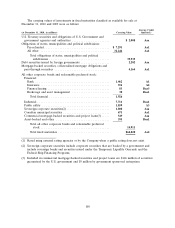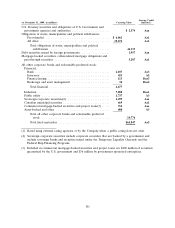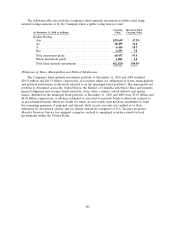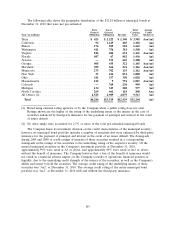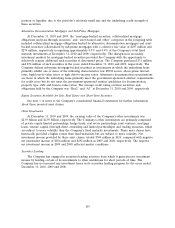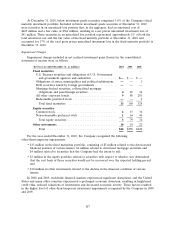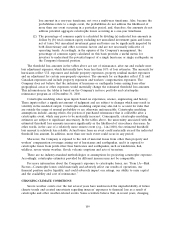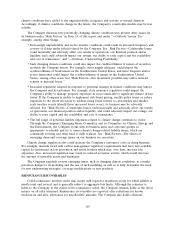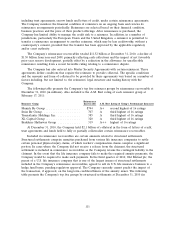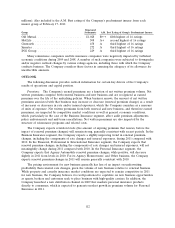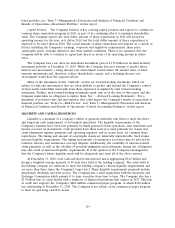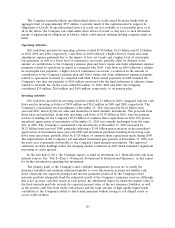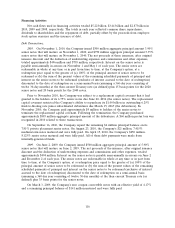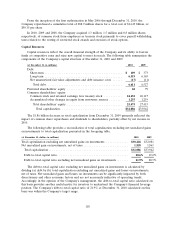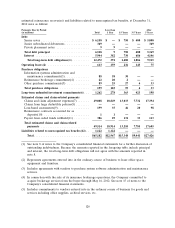Travelers 2010 Annual Report Download - page 122
Download and view the complete annual report
Please find page 122 of the 2010 Travelers annual report below. You can navigate through the pages in the report by either clicking on the pages listed below, or by using the keyword search tool below to find specific information within the annual report.climate conditions have added to the unpredictability, frequency and severity of natural disasters.
Accordingly, if climate conditions change in the future, the Company’s catastrophe models may be less
reliable.
The Company discusses how potentially changing climate conditions may present other issues for
its business under ‘‘Risk Factors’’ in Item 1A of this report and under ‘‘—Outlook’’ herein. For
example, among other things:
• Increasingly unpredictable and severe weather conditions could result in increased frequency and
severity of claims under policies issued by the Company. See ‘‘Risk Factors—Catastrophe losses
could materially and adversely affect our results of operations, our financial position and/or
liquidity, and could adversely impact our ratings, our ability to raise capital and the availability
and cost of reinsurance’’ and ‘‘—Outlook—Underwriting Profitability.’’
• Such changing climate conditions could also impact the creditworthiness of issuers of securities
in which the Company invests. For example, water supply adequacy could impact the
creditworthiness of bond issuers in the Southwestern United States, and more frequent and/or
severe hurricanes could impact the creditworthiness of issuers in the Southeastern United
States., among other areas. See ‘‘Risk Factors—Our investment portfolio may suffer reduced
returns or material losses.’’
• Increased regulation adopted in response to potential changes in climate conditions may impact
the Company and its customers. For example, state insurance regulation could impact the
Company’s ability to manage property exposures in areas vulnerable to significant climate driven
losses. If the Company is unable to implement risk based pricing, modify policy terms or reduce
exposures to the extent necessary to address rising losses related to catastrophes and smaller
scale weather events (should those increased losses occur), its business may be adversely
affected. See ‘‘Risk Factors—Catastrophe losses could materially and adversely affect our results
of operations, our financial position and/or liquidity, and could adversely impact our ratings, our
ability to raise capital and the availability and cost of reinsurance.’’
• The full range of potential liability exposures related to climate change continues to evolve.
Through the Company’s Emerging Issues Committee and its Committee on Climate, Energy and
the Environment, the Company works with its business units and corporate groups as
appropriate to identify and try to assess climate change-related liability issues, which are
continually evolving and often hard to fully evaluate. See ‘‘Risk Factors—The effects of
emerging claim and coverage issues on our business are uncertain.’’
Climate change regulation also could increase the Company’s customers’ costs of doing business.
For example, insureds faced with carbon management regulatory requirements may have less available
capital for investment in loss prevention and safety features which may, over time, increase loss
exposures. Also, increased regulation may result in reduced economic activity, which would decrease
the amount of insurable assets and businesses.
The Company regularly reviews emerging issues, such as changing climate conditions, to consider
potential changes to its modeling and the use of such modeling, as well as to help determine the need
for new underwriting strategies, coverage modifications or new products.
REINSURANCE RECOVERABLES
Ceded reinsurance involves credit risk, except with regard to mandatory pools for which liability is
mostly joint and several, and is generally subject to aggregate loss limits. Although the reinsurer is
liable to the Company to the extent of the reinsurance ceded, the Company remains liable as the direct
insurer on all risks reinsured. Reinsurance recoverables are reported after reductions for known
insolvencies and after allowances for uncollectible amounts. The Company also holds collateral,
110


